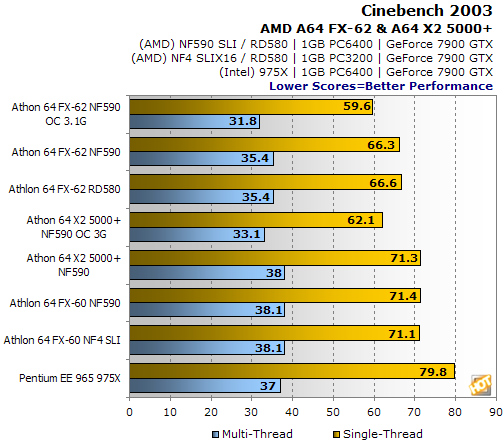AMD Athlon 64 FX-62 And X2 5000+ Socket AM2, nForce 590 SLI & ATI RD580
The Cinebench 2003 benchmark is an OpenGL 3D rendering performance test, based on the commercially available Cinema 4D application.
|
|
|
This is a multi-threaded, multi-processor aware benchmark that renders a single 3D scene and tracks the length of the entire process. The time it took each test system to render the entire scene is represented in the graph below (listed in seconds)

We decided to toss in a couple of surprises in this test, so pay attention to the system specs in this chart. You'll notice 3GHz+ overclocked scores are listed for the Althlon 64 X2 5000+ and the Athlon 64 FX-62. In either case, AMD's Athlon 64 core architecture has an easier time with Cinebench than Intel's, whether in single or multi-threaded mode. Further, there is no advantage whatsoever for DDR2 and the AM2 platform in this test, as you can observe by comparing the FX-60 clocked AM2 scores versus the FX-60 on NF4 SLI and DDR-400 memory.
|
|
|
3DMark06's built-in CPU test is a multi-threaded "gaming related" DirectX metric that's useful for comparing relative performance between similarly equipped systems. This test consists of two different 3D scenes that are generated with a software renderer, which is dependant on the host CPU's performance. This means that the calculations normally reserved for your 3D accelerator are instead sent to the central processor. The number of frames generated per second in each test are used to determine the final score.

For gaming workloads, 3DMark06 shows all processors in this test on a fairly level playing field and we couldn't agree more. There is less than a 2% advantage for AMD's fastest over Intel's fastest and the AM2 platform is showing performance on par with the highly turned and mature socket 939 nForce 4 system.






